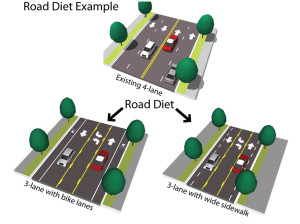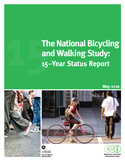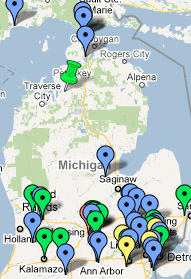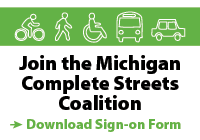You are currently browsing the tag archive for the ‘resources’ tag.
After the State Transportation Commission officially adopted a Complete Streets policy on July 26th, 2012, as required by PA 134 and PA 135 of 2010, the Michigan Department of Transportation wasted no time in getting the word out about the good news. Upon request from the Michigan Complete Streets Advisory Council, MDOT recently published this one-page leave behind regarding the new policy in an effort to help inform internal staff, as well as road commissions, municipalities, and other interest groups across the state.
The one-pager includes the following vision for Complete Streets in Michigan:
- A transportation network that is accessible, interconnected and multimodal and that safely and efficiently moves goods and people of all ages and abilities throughout the State of Michigan.
- A process that empowers partnerships to routinely plan, fund, design, construct, maintain and operate complete streets that respect context and community values.
- Outcomes that will improve economic prosperity, equity, accessibility, safety and environmental quality.
Download the one-pager or preview it below.
 The Michigan Chapter of the American Planning Association published an extensive and explanatory article about complete streets in its monthly magazine, the Michigan Planner. A word version of the article, written by Brad Strader, can be downloaded here. Great work!
The Michigan Chapter of the American Planning Association published an extensive and explanatory article about complete streets in its monthly magazine, the Michigan Planner. A word version of the article, written by Brad Strader, can be downloaded here. Great work!
Here’s a cool blog post and infographic from good.is on the rising popularity of people powered transportation. With the Michigan House of Representatives scheduled to vote on the Complete Streets legislation, this is particularly timely. Passing the legislation will make it even easier for Michigan citizens to continue to increasingly choose walking and biking over automobiles.
“It’s summer, and you may be seeing more people out on the street walking and biking. But it’s not just because the weather is nice. There are more people walking and biking year round, and the Department of Transportation is responding by dramatically increasing the amount of money spent on projects for pedestrians and cyclists.”
 The infographic is derived from the 15-year Status Report, which is the third status update to the National Bicycling and Walking Study, originally published in 1994 as an assessment of bicycling and walking as transportation modes in the United States. The report gives an update on the two main goals of the 1994 study: reducing fatalities and increasing the number of trips made by walking and biking. The good news is that improvements were made in both, but funding for these alternatives to automobiles still accounts for only about 2% of transportation funding, so there’s still some work to do. The report also notes that “one of the fastest-growing efforts to promote bicycling and walking is the adoption of Complete Streets policies.”
The infographic is derived from the 15-year Status Report, which is the third status update to the National Bicycling and Walking Study, originally published in 1994 as an assessment of bicycling and walking as transportation modes in the United States. The report gives an update on the two main goals of the 1994 study: reducing fatalities and increasing the number of trips made by walking and biking. The good news is that improvements were made in both, but funding for these alternatives to automobiles still accounts for only about 2% of transportation funding, so there’s still some work to do. The report also notes that “one of the fastest-growing efforts to promote bicycling and walking is the adoption of Complete Streets policies.”
Lack of funding leads to destruction of Montcalm County roads
A YouTube video released today documents the intentional pulverization of paved roadways in Montcalm County. Faced with dwindling funds for road maintenance, many Michigan counties are being forced to replace paved roads with gravel.
While many Michigan roads are certainly in need of repair, it would be irresponsible to consider a road “fixed” until it is “complete,” meaning it accomodates all modes of transportation including pedestrians, bicyclists, transit users and those with disabilities - not just cars.
When incorporated into the original design of a roadway, Complete Streets practices often cost little extra to implement. Advocates for Complete Streets need to reframe the issue of cost into an issue of value. We must start placing value on the proper construction and maintenance of the entire right of way, not just the number of miles of paved travel lanes. This means that the many engineers, planners and politicians who have ignored the needs of the 1/3 of Americans who do not drive will have to stop treating bicyclists, pedestrians, transit users and those using mobility aides as second class citizens. Placing emphasis on value may indeed mean that communities might have to repave a few less miles of road each year and use those savings to make the roadways that they do “fix” complete.
Learn more about the costs of Complete Streets at:
http://www.completestreets.org/complete-streets-fundamentals/factsheets/costs/
















